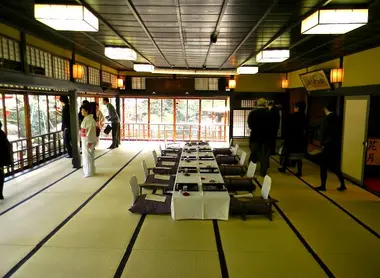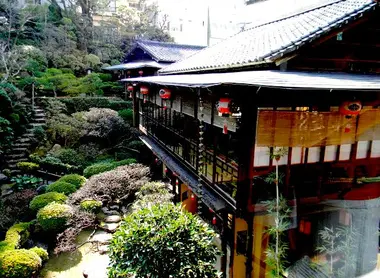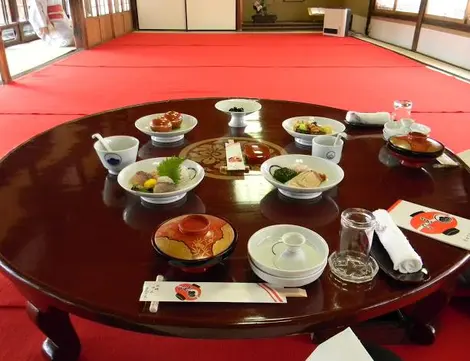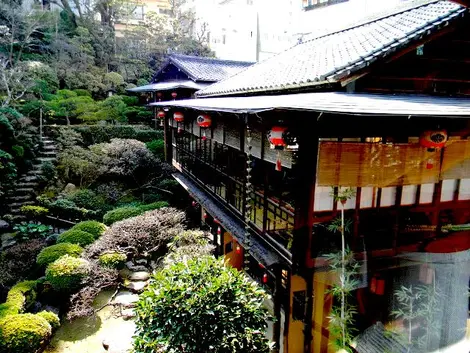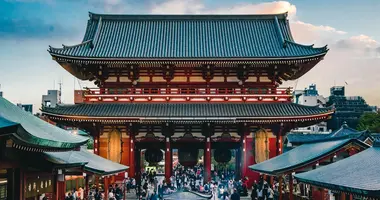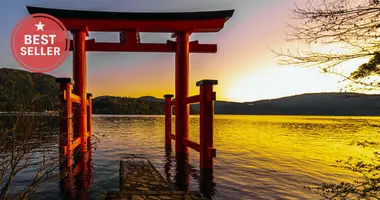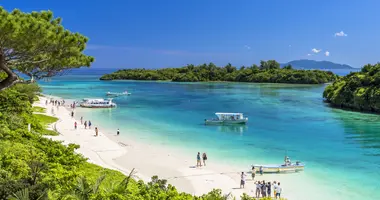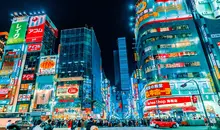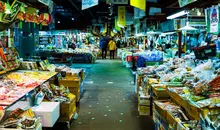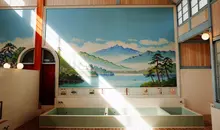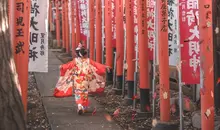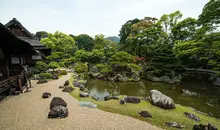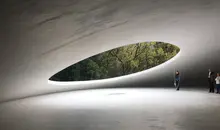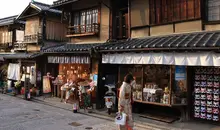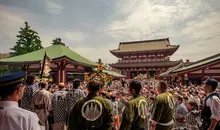Kagetsu Nagasaki: a historic restaurant at the heart of Japan's cultural heritage
- Published on : 07/11/2014
- by : G.L.
- Youtube
Shippoku ultra-chic
In the heart of Nagasaki stands Kagetsu, a culinary institution and an iconic Japanese landmark . Founded in 1642 in the Maruyama district, this prestigious establishment is now recognized as Japan's oldest luxury restaurant (ryôtei). Once a geisha house with a sulphurous past, Kagetsu has been transformed into a gastronomic temple where you can savour Shippoku cuisine, a perfect reflection of Nagasaki's unique cultural mix. Its walls, steeped in history, have welcomed illustrious guests to savor its refined cuisine and admire its magnificent 2,645-square-meter Japanese garden. Immerse yourself in a place where culinary art meets history, and where every meal becomes an unforgettable cultural experience.
History of Kagetsu: from its origins in the Maruyama red light district to the present day
The history of Kagetsu began in 1642, during the Kan'ei era, when the Maruyama Yukaku red light district was officially established in Nagasaki by consolidating the brothels scattered around the city. This district was particularly renowned as it was the only pleasure district accessible to foreigners in Japan, rivalling in prestige those of Shinmachi in Osaka, Shimabara in Kyoto and Yoshiwara in Edo (ancient Tokyo).
The name "Kagetsu" (花月, meaning "moon flower") was taken from Hiketa-ya Honke, Maruyama's most prestigious "Tayu-ya" - an establishment that employed courtesans of the highest rank in the prostitution hierarchy of the time. Nagasaki locals called Hiketa-ya Honke "Kagetsu-rou", Shin-Hiketa-ya "Kakuju-tei", and Shin-Hiketa-ten "Roushin-rou". Of all these establishments, only Hiketa-ya operated without interruption from Maruyama Yukaku's creation until the Geishogi kaihorei ( order for the liberation of geishas and prostitutes ) in 1872, during the Meiji era.
Today's "Kagetsu Historical Japanese Restaurant" has preserved Hiketa-ya Honke's original garden and building, retaining the authentic atmosphere of the place. Over the centuries, the establishment has been transformed from a luxury brothel into a first-rate gourmet restaurant, while retaining its historic character which today makes it a listed cultural heritage building. The place has witnessed key moments in Japanese history, notably at the end of the Edo period, when many intellectuals and patriots gathered here to discuss the future of Japan, earning it the reputation of being a veritable"international literary salon".
Shippoku-ryori: a unique cuisine born of cultural fusion in Nagasaki
The Shippoku-ryori (卓袱料理) served at Kagetsu is much more than just a cuisine - it's a living testimony to Nagasaki's multicultural history. This refined gastronomy developed thanks to the unique cultural interactions between Japan and the foreign nations that traded with Nagasaki during the country's period of isolation (sakoku), notably China, Portugal and the Netherlands.
The essence of Shippoku-ryori lies in its fusion of Japanese, Chinese and Western culinary elements. It borrows from Japanese kaiseki its structure of serving several small, aesthetically arranged dishes, while incorporating techniques and ingredients from elsewhere. A distinctive feature of Shippoku is the traditional presentation around a round red table, inspired by Chinese banquets, where diners share dishes in a spirit of conviviality - an unusual practice in traditional Japanese cuisine, where meals are usually served individually.
At Kagetsu, the Shippoku menu features some 15 carefully orchestrated dishes, reflecting this cultural richness: ozôni (mochi soup), soba (buckwheat noodles), fresh seafood, Chinese-style braised pork, sometimes even whale prepared according to ancestral recipes, and desserts inspired by Portuguese pastries. Each dish is served in carefully selected, precious crockery, contributing to the visual as well as the gustatory experience. This succession of delicate dishes is sometimes accompanied by the delicate sound of a koto (traditional stringed instrument) played in an adjacent room, adding an extra sensory dimension to the meal.
Kagetsu's Shippoku cuisine, available from 10,000 yen for a lunch menu (and double that in the evening), represents the living legacy of Nagasaki's exceptional status as Japan's window on the world during centuries of isolation. It reminds us that the Chinese community has long-standing ties with Nagasaki (whose Chinatown is the oldest in Japan), and that Portuguese sailors and missionaries were the first Westerners to set foot on the archipelago in the mid-16th century.
Kagetsu's historic halls: remarkable architecture and fittings
The interior spaces of Kagetsu are true architectural gems, bearing witness to over three centuries of history. Upon entering, visitors are greeted with traditional courtesy in sumptuous wooden corridors leading to nine unique rooms, each with its own character and history.
Among these remarkable spaces is Japan's first Western-style hall, a precious architectural testimony to the country's gradual opening up to foreign influences. The establishment also includes a spacious 45 tatami hall (approx. 72 square meters), which can be used for large banquets and celebrations.
The most prestigious halls bear evocative names such as "Ryu-no-ma" (Dragon Hall) and "Fuji-no-ma" (Mount Fuji Hall), the latter accommodating up to 150 people for ceremonies and receptions. The Dragon Room offers a breathtaking view of the Japanese garden, creating a harmonious connection between inside and outside.
These spaces bear the imprint of illustrious visitors who have left their mark on Japanese history. Ryoma Sakamoto, the famous samurai who played a crucial role in Japan's modernization, is said to have left marks from his sword on one of the restaurant's pillars during a festive evening. Similarly, Katsu Kaishu, an important negotiator who contributed to the peaceful resolution of many of Japan's internal conflicts in the 19th century, had his own favorite room, where you can still admire his handwritten calligraphy.
The authentic atmosphere of these rooms has been preserved with meticulous care, offering contemporary visitors an immersion in the refined elegance of the Edo period. Even today, the private rooms can host dinners accompanied by geisha performances, perpetuating Maruyama's cultural traditions.
The Japanese garden: a contemplative space reflecting the seasons
The magnificent Kagetsu Japanese Garden is one of Nagasaki's hidden treasures. Covering an impressive 2,645 square meters (800 tsubos), this historic garden is a haven of peace in the heart of the city, and an outstanding example of traditional Japanese landscape art.
Designed according to the principles of the gardens of the Genroku era (1688-1704), considered the golden age of Japanese culture, the Kagetsu garden is characterized by a carefully considered composition in which each element - stones, water, plants and structures - finds its place in perfect balance. This garden is not simply a space for pleasure, but a living work of art that reflects Japanese aesthetic philosophy.
One of the garden's most appreciated features is its ability to celebrate the cycle of the seasons, offering different natural tableaux throughout the year. In early spring, plum blossoms (ume ) herald renewal with their delicate blooms. Summer sees the blossoming of magnificent azaleas, adding touches of vibrant color. In autumn, the garden is transformed into a symphony of reds and oranges as the maple leaves take on their autumnal hues.
Visible from several of the restaurant's rooms, including the "Ryu-no-ma", the garden creates a striking backdrop for the meals and celebrations held there. For the traditional weddings held at Kagetsu, this green setting provides an idyllic backdrop for ceremonies and commemorative photographs.
The preservation of this historic garden in its original form testifies to Kagetsu's commitment to keeping Nagasaki's cultural heritage alive. For contemporary visitors, a contemplative pause in this century-old garden is an opportunity to connect with Japanese history and aesthetic traditions, while enjoying a space of serenity preserved from urban tumult.
Famous personalities who have visited Kagetsu: an international literary salon
Over the centuries, Kagetsu has established itself as much more than just a place for dining and entertainment - it has become a veritable intellectual and cultural crossroads where eminent personalities who have shaped Japan's history and its relations with the outside world have come together.
During the critical period of the late Edo and early Meiji eras (mid-to-late 19th century), Kagetsu served as a discreet meeting place for thinkers and reformers who envisioned a Japan open to the world. It was in these halls that visionary samurai like Ryoma Sakamoto discussed the country's future and devised strategies for its modernization. Legend has it that, during a particularly lively evening, Sakamoto left sword marks on one of the restaurant's pillars - marks that are still visible today and bear witness to those tumultuous times.
Katsu Kaishu, another major figure of this transitional era and a talented negotiator, had his favorite room at Kagetsu. He left a calligraphy there bearing the message "If we do what we must, our future opens up before us" - words that still resonate with the philosophy of the place. Numerous intellectuals, artists and politicians have also frequented the premises to hone their creative vision and ideas.
What made Kagetsu so special was its ability to attract not only the Japanese elite, but also distinguished foreign visitors, in keeping with Nagasaki's tradition of international openness. This cosmopolitan dimension earned Kagetsu its reputation as an "international literary salon", a place where ideas flowed freely and cultures met in an atmosphere of refinement.
Even today, Kagetsu retains this cultural aura and continues to attract contemporary personalities who come to discover or rediscover this place steeped in history. Every room, every nook and cranny of the restaurant tells fragments of Japan's intellectual history, making Kagetsu a veritable living museum of the cultural exchanges that have shaped Nagasaki and, by extension, modern Japan.
Ceremonies and banquets at Kagetsu: traditions and contemporary celebrations
Kagetsu is not only a historic restaurant and a place of remembrance, it's also a living space where traditions linked to the major stages of Japanese life are perpetuated and reinvented. Today, the establishment is particularly sought-after for ceremonies and banquets that combine respect for ancestral customs with a contemporary sensibility.
Traditional wedding ceremonies are among the most emblematic events held at Kagetsu. They can take the form of a Shinzen-shiki (Shinto ceremony) in the "Kagetsu-rou" space in the heart of the Japanese garden, where a Shinto priest officiates in a solemn setting with the forest in the background. Alternatively, the couple can opt for a Jinzen-shiki (non-religious ceremony) in the vast garden, particularly appreciated for its exceptional natural setting.
For the wedding receptions that follow, Kagetsu offers a range of original artistic directions: celebratory dances performed by Maruyama's geishas, the Mochi-tsuki ceremony (pounding rice to make rice cakes) symbolizing the couple's first "teamwork", traditional shamisen music played by geishas as the bride and groom depart, or a cake-cutting ceremony using Momo-Castella, a specialty unique to Nagasaki.
In addition to weddings, Kagetsu hosts other important celebrations in Japanese culture. The "Coming-of-Age" plan is designed for coming-of-age ceremonies, while the "Yuinou" plan accompanies traditional engagements. For young children, the "Okuizome" plan symbolically celebrates the baby's first meal, and for the elderly, the "Longevity Celebration Plan" honors important birthdays.
These ceremonies adapt to contemporary needs while respecting the spirit of tradition. Kagetsu offers a variety of formulas, from intimate ceremonies reserved for the couple or close family, to large-scale receptions for over 100 guests. Prices vary according to the number of participants and services chosen, starting at 85,800 yen (tax included) for a private ceremony for the couple only, including traditional clothing, hairstyling, make-up, photos and a kaiseki meal for two.
By perpetuating these traditions in an authentic historical setting, Kagetsu offers guests a unique experience where Japanese cultural heritage blends with personal celebrations, creating lasting memories rooted in Nagasaki's history. For information or reservations, please contact the restaurant on +81 (0)95-822-0191 or visit their website: http: //www.ryoutei-kagetsu.co.jp.
Address, timetable & access
Address
Phone
+81 (0)95-822-0191Timetable
Every day except Tuesday, 12pm - 10pmPrice
10,000 yen for a shippoku menu at lunchtime, double for dinner.
Reservations for 2 people minimum.Access
Shianbashi streetcar stop, take Shianbashi-dôri and go straight on to Maruyama Square.
Kagetsu is at the far left of the small square.Website
http://www.ryoutei-kagetsu.co.jp

